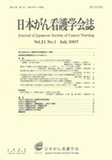Japanese
English
- 販売していません
- Abstract 文献概要
- 参考文献 Reference
- サイト内被引用 Cited by
要旨
本研究では,終末期がん患者を看取る家族が活用する折り合い方法を明らかにした.折り合いを「患者の避けられない死に直面した家族が,葛藤を解決するために活用する対処」と定義した.対象者は,緩和ケア病棟あるいは一般病棟で看病する家族19人であった.半構成的面接および参加観察法によってデータ収集し,Krippendorffの内容分析法でデータ分析を行った.結果,家族が活用する折り合い方法として,《納得のための吟味》《受け入れやすさへの転換》《面倒を避ける算段》《負担の分散》《不一致を埋める接近》《あきらめの作業》《添い方を変える》が明らかとなった.これらの方法は,看取りにおける葛藤を解決するために活用されており,状況や自分の行動を受け入れる,面倒や負担から自分を守る,可能な添い方を試みるという機能を発揮すると考えられた.
Abstract
This qualitative study investigates how family caregivers come to terms with having a terminally ill member. Coming to terms was defined as coping. The concept of coming to terms involved several themes, including facing the inevitability of death, conflicts, and conflict resolution. The subjects were 19 family caregivers in a palliative care and general hospital care setting. A semi-structured taped interview and observations were used to collect data, and the Content Analysis Method by Krippendorff was used to analyze data. Ways of coming to terms were "focusing on the evidence to accept the existing situation" "finding positives" "finding ways of avoiding trouble" "sharing the burden" "finding approaches to solving disagreements" "accepting resignation" and "changing one's way of giving care". Ways of coming to terms were used to resolve conflicts. The researcher suggests that these ways of coming to terms have three functions: to accept the dying process and one's own caregiving behavior, to protect oneself from burden, and to try to keep giving care.
Copyright © 2007, Japanese Society of Cancer Nursing All rights reserved.


